The Botanist of Madresfield
- 16th November 2021
Anthony, one of our Archive team, has been looking into Isabella Ann Allen of Madresfield, a significant but little known 19th century botanist.
It is fair to say that in the past few years I have become a passionate, if perhaps, a bit untidy, Gardener. It is due to my interest in the history of natural history that I have the plant hunters of the 19th century to thank for the huge varieties of plants from Europe, Asia and America that are grown in British Gardens today (though this hasn’t always been to our benefit through introduced pests and diseases). Whilst the majority of plant hunters during this period were men, there were women like Marianne North, Anna Atkins and Amelia Warren Griffiths who made important contributions to botany through botanical illustration, cyanotype photography and specimen collecting.
The pursuit of Botany during the Victorian period was an acceptable pastime for young women. Seaweed collecting was incredibly popular thanks to Griffiths who raised awareness about the diverse marine life in Devon where she collected, making seaweed collecting and seaside holidays popular. Having grown up in Devon myself, I have always enjoyed exploring the coastline and observing the diverse range of seaweeds. Seaweed and plant collecting in the 19th century was a way for women to explore the natural world, who sadly at the time were not expected to study science for its own sake, but often as a social accomplishment. Though of course, there were exceptions.
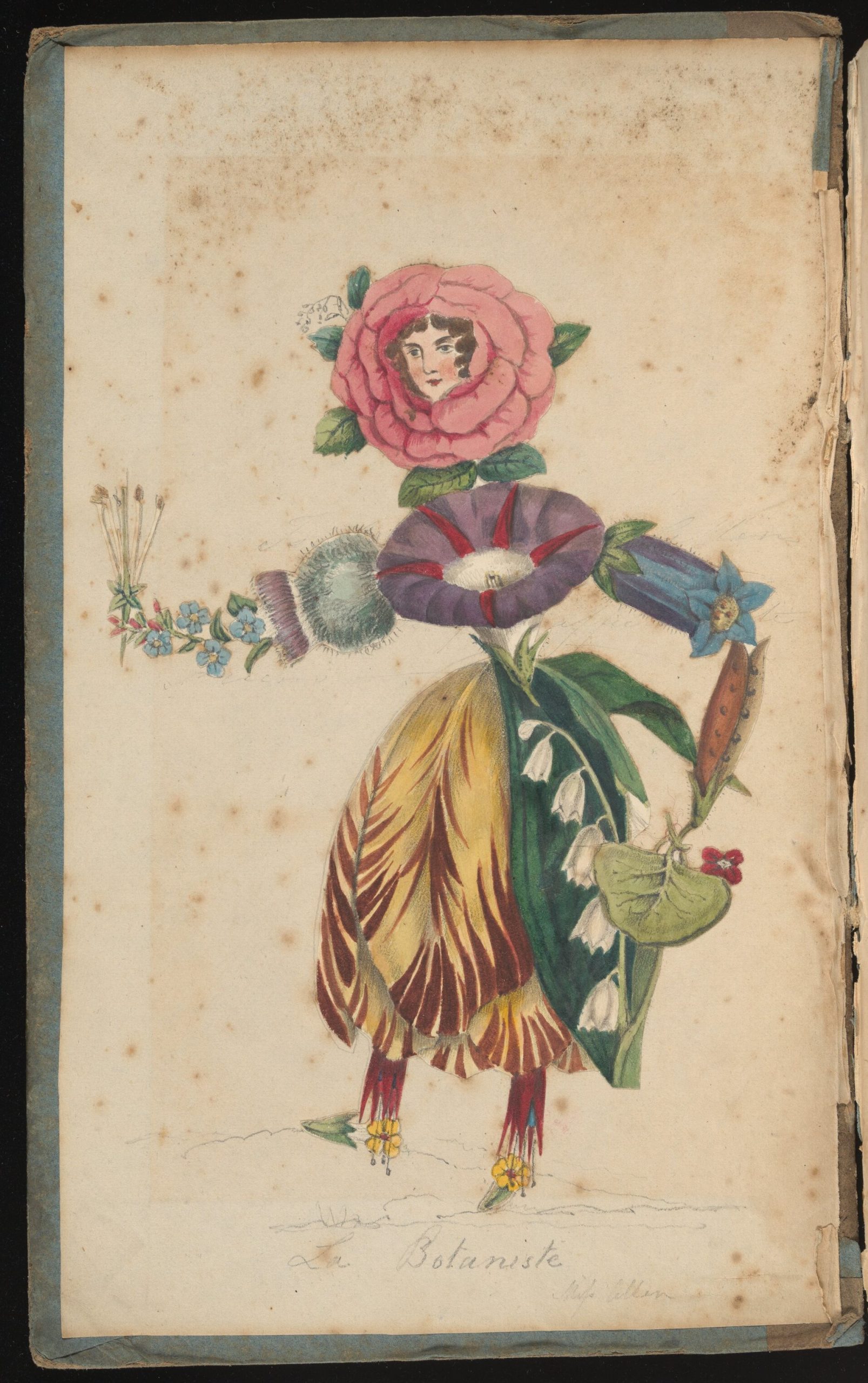
‘La Botaniste’. Inside cover, The English flora, Sir James Edward Smith. 1824-1833. © RHS Lindley Collections
So, it was with some excitement, that a colleague’s discovery of a news report entitled ‘Mystery 19th Century botanist tracked down following appeal’ by the Royal Horticultural Society’s (RHS) Lindley Library who thanks to the public had identified the owner of a donated copy of The English Flora using ‘clues such as pressed flowers, poems and doodles’ as Miss Isabella Ann Allen of The Rhydd, in the parish of Madresfield. Wishing to learn more about Isabella’s life, whose identity had literally been held within the pages of this book, we made some fascinating discoveries using the Allen family archive held at WAAS under Ref: 899:795 BA 9276, local and family history sources and her Will.
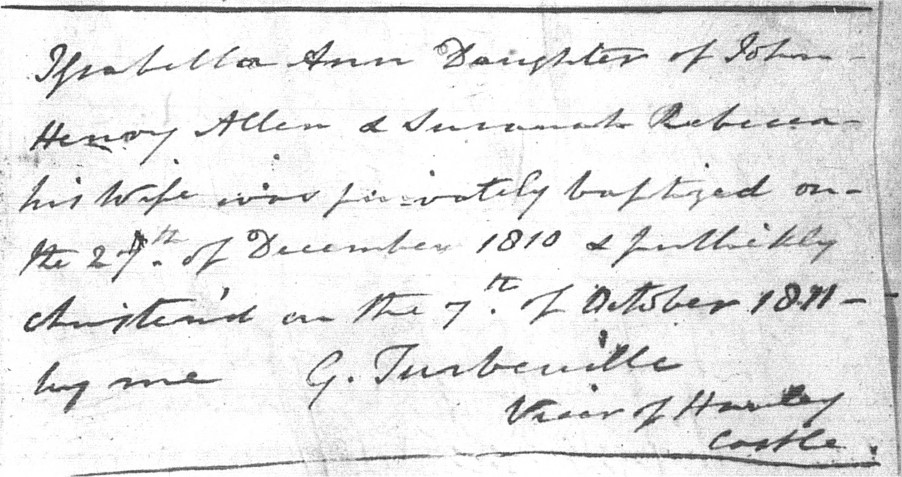
Baptism record of Isabella Anne Allen, Madresfield Ref 850 Madresfield, 1810 © WAAS
Isabella Ann ‘Daughter of John Henry Allen and Susannah Rebecca’ was privately baptised on 27th December 1810 as shown from the Madresfield parish register. This may simply be because of her family’s status or Isabella may have been sickly in the first few months of her life as it wasn’t until the 7th October 1811 that Isabella was publicly baptised in Hanley Castle. We know from the Tithe map, 1841 Census and family accounts that John Henry Allen, Isabella’s father was an important landowner who owned not only the Rhydd House – the family home of the Allen’s, but the surrounding land and property.
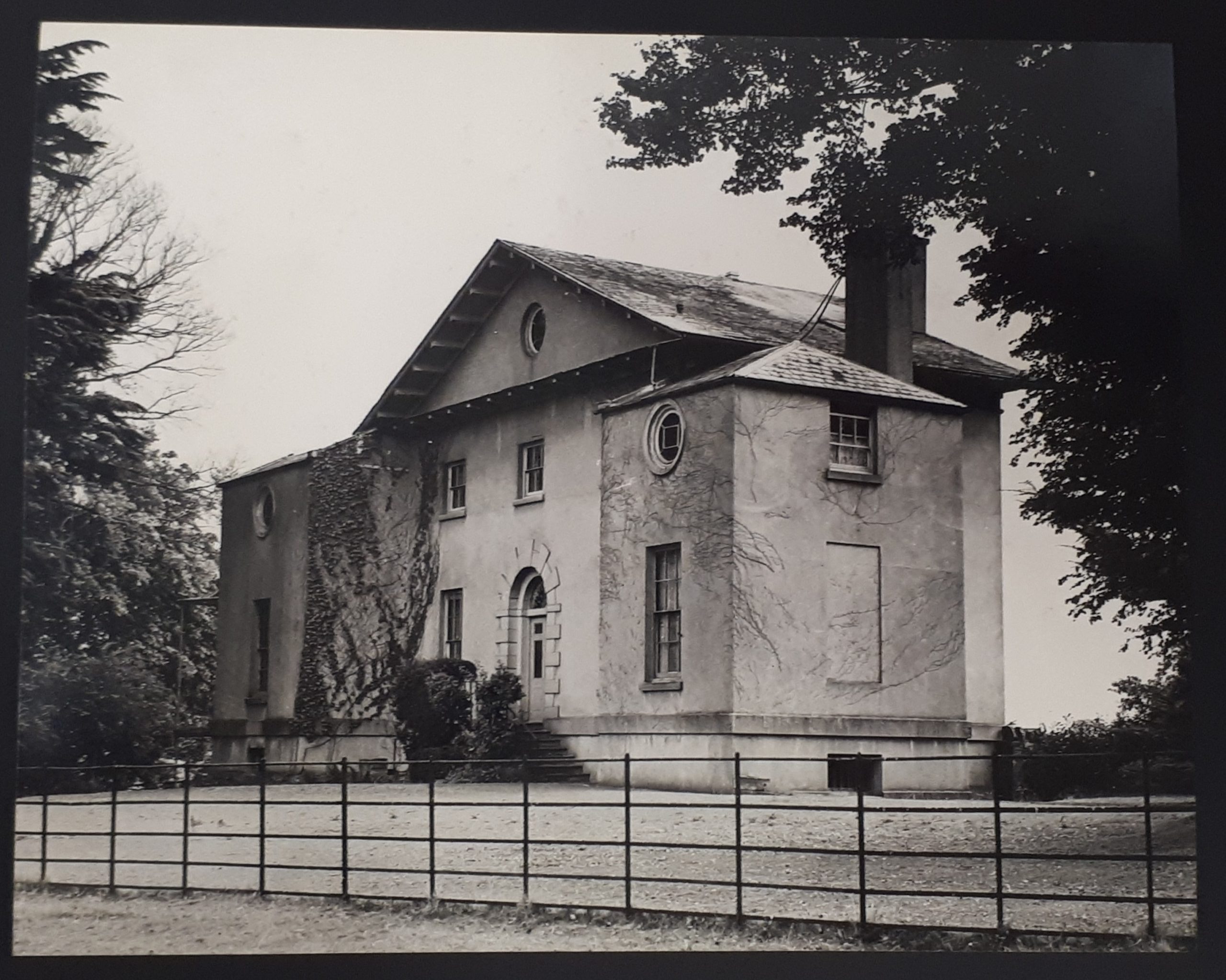
The Rhydd, Hanley Castle – the original house was destroyed by fire in 1922 WPS Ref 982.072 BA 3733© WAAS
The Allen family were well known to the nearby Lechmere family of Hanley Castle whose archive is also held with us at Ref: 705:134. Indeed, her brother the Rev. Charles Allen whose accounts and correspondence we have corresponded directly with Sir Edmund Lechmere regarding the restoration of Tewkesbury Abbey [Glos.] and related matters at Ref: 899:795 BA 9276/6/ (v). However, the relationship with Sir. Edmund Lechmere was not always cordial, as will become apparent later.
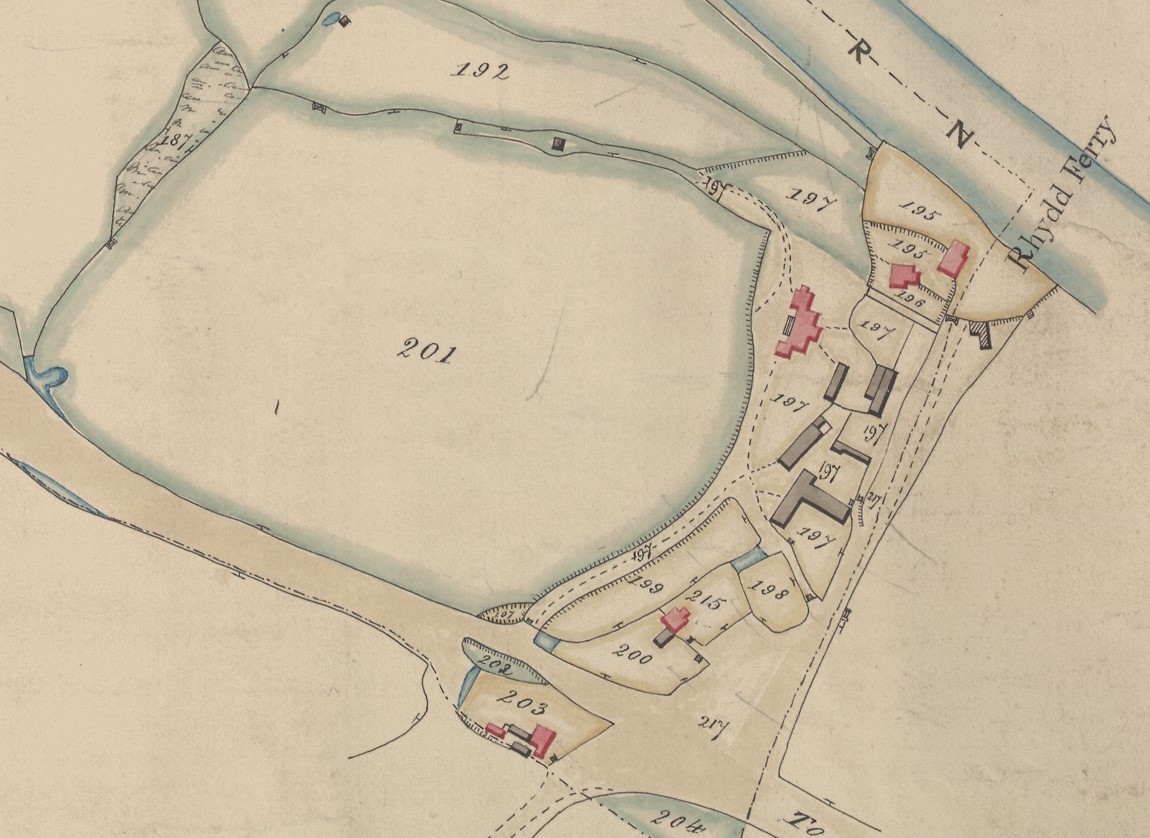
The Rhydd & Quay as shown on the Madresfield Tithe Map of 1840 Ref: s760/434 BA 1572
We get a sense of the community at The Rhydd and the life that Isabella would have enjoyed with her family thanks to the Tithe map and apportionment which in 1840 list John Henry Allen as the landowner. Plot 197 is described as House, Carriage Drive, Pleasure Garden & Outbuildings, with plots 198-199 comprising an Outer Garden, Pool and Kitchen Garden. This closely matches the description provided by historic parks and gardens which describes The Rhydd, Hanley Castle ‘a house of about 1800 remodelled in 1863. It sits in a large landscape park overlooking the River Severn. features include a summerhouse, a large kitchen garden, a fountain and geometric beds.’
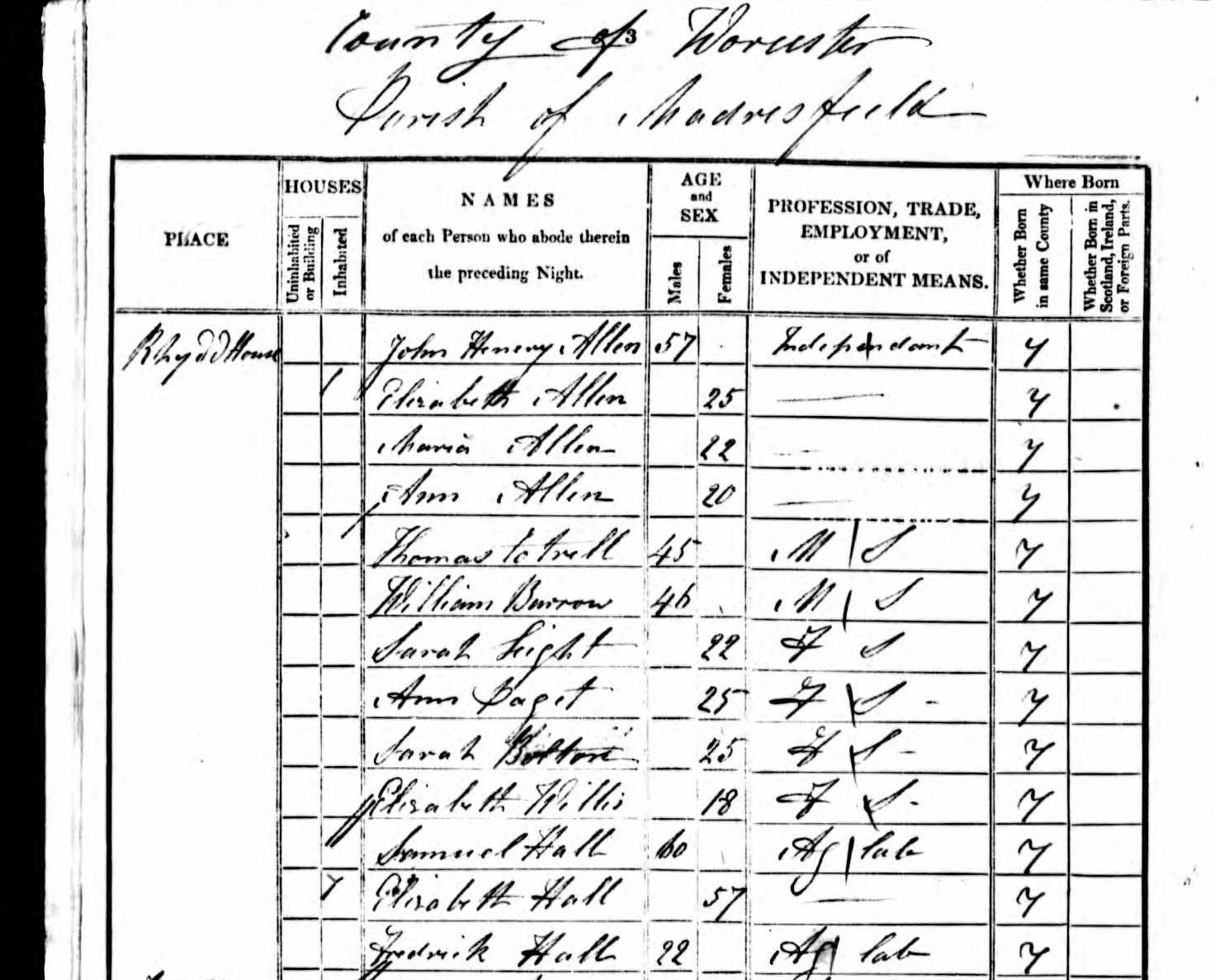
1841 Census showing the Allen family at Rhydd House © Crown Copyright
On the 1841 Census, John Henry Allen’s profession is listed as ‘Independent’ demonstrating his wealth as the head of a landowning family. However his wife Susannah has sadly died, leaving him to care for his daughters, the eldest of which is Elizabeth Allen aged 25, then Maria Allen [22] and the youngest Ann Allen [20]. To confuse things, this isn’t Isabella Ann Allen, but her youngest sister Ann, who was baptised in 1818 and given Isabella was baptised in 1810, she would be at least 30 by 1841. Both Isabella and her brother Charles Allen, born in 1821 and who would later become the Rev. Charles Allen, Vicar of Bushley are curiously absent when the Census was taken on this day in 1841.
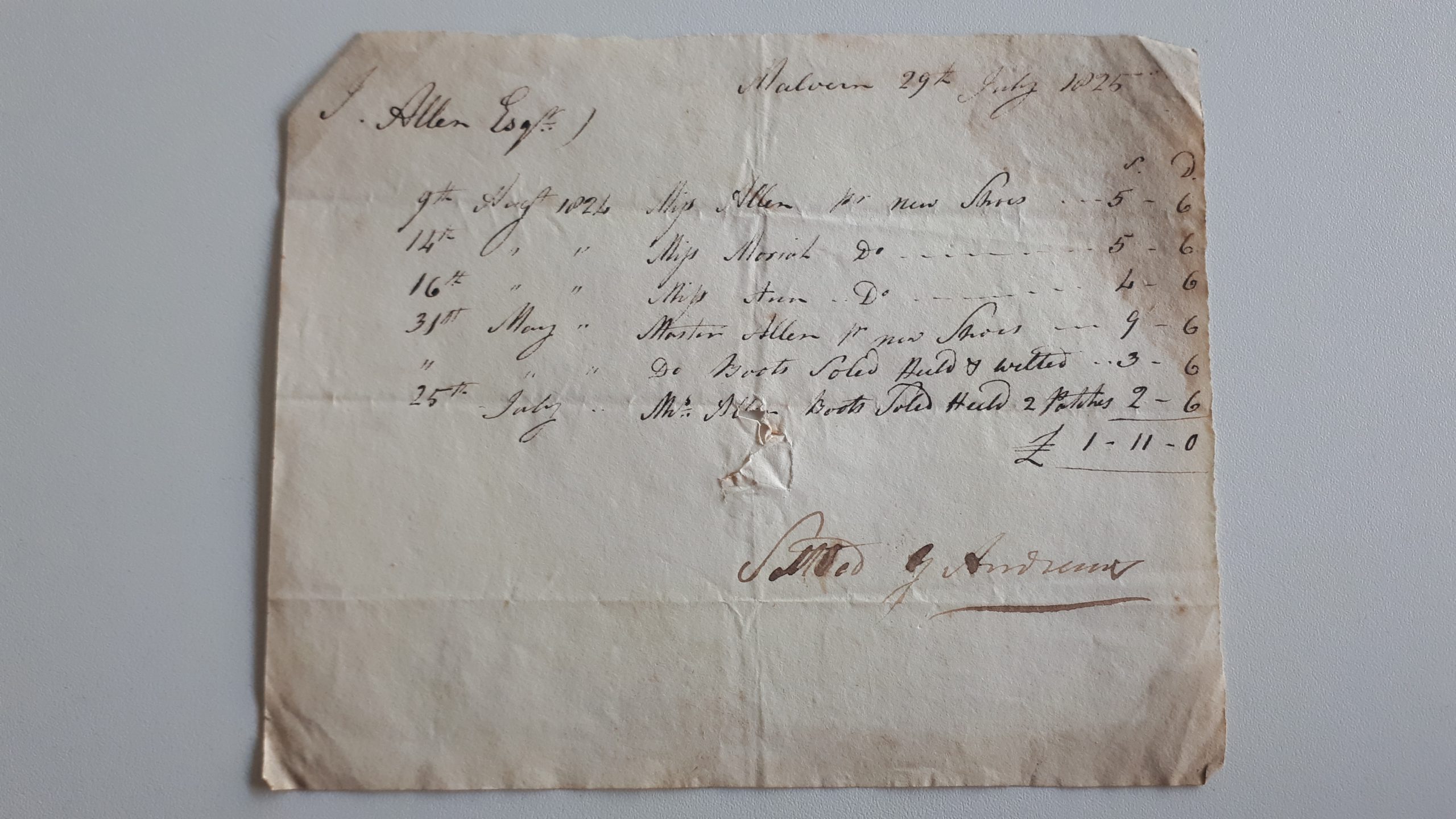
J. H. Allen Esq. Expenses for new shoes Malvern 29th July 1825 Ref 899.975 9276.(i) 4 © WAAS
The household staff of two male servants and four female servants on the Census demonstrate, along with the size of the estate and expenses and accounts of John Henry Allen Esq. shown that The Allens were a wealthy family. At Ref: 899:795 9276.(i) 4 dated 29th July 1825 (Malvern) as part of there is a receipt for new shoes for Miss Allen, Maria(h), Ann, Master Allen (Charles Allen) and Mrs Allen who required ‘Boots soled heeled 2 patches’ for one pound eleven shillings which in today’s money is roughly £106.00 which given the average price of shoes today is pretty good value! Cheaper than your average car today, but which further demonstrates their wealth at Ref: 899.795 BA9276.6.1.33 is a ‘Receipt of Mr. Allen for a Yellow Charriot (horse drawn carriage) for £120 by me, R. Franklin’. A cost today of at least £11,000! Therefore, Isabella would have lived a privileged and financially secure life which would have enabled her to pursue her interests, albeit alongside the expectations of family and society at this time.
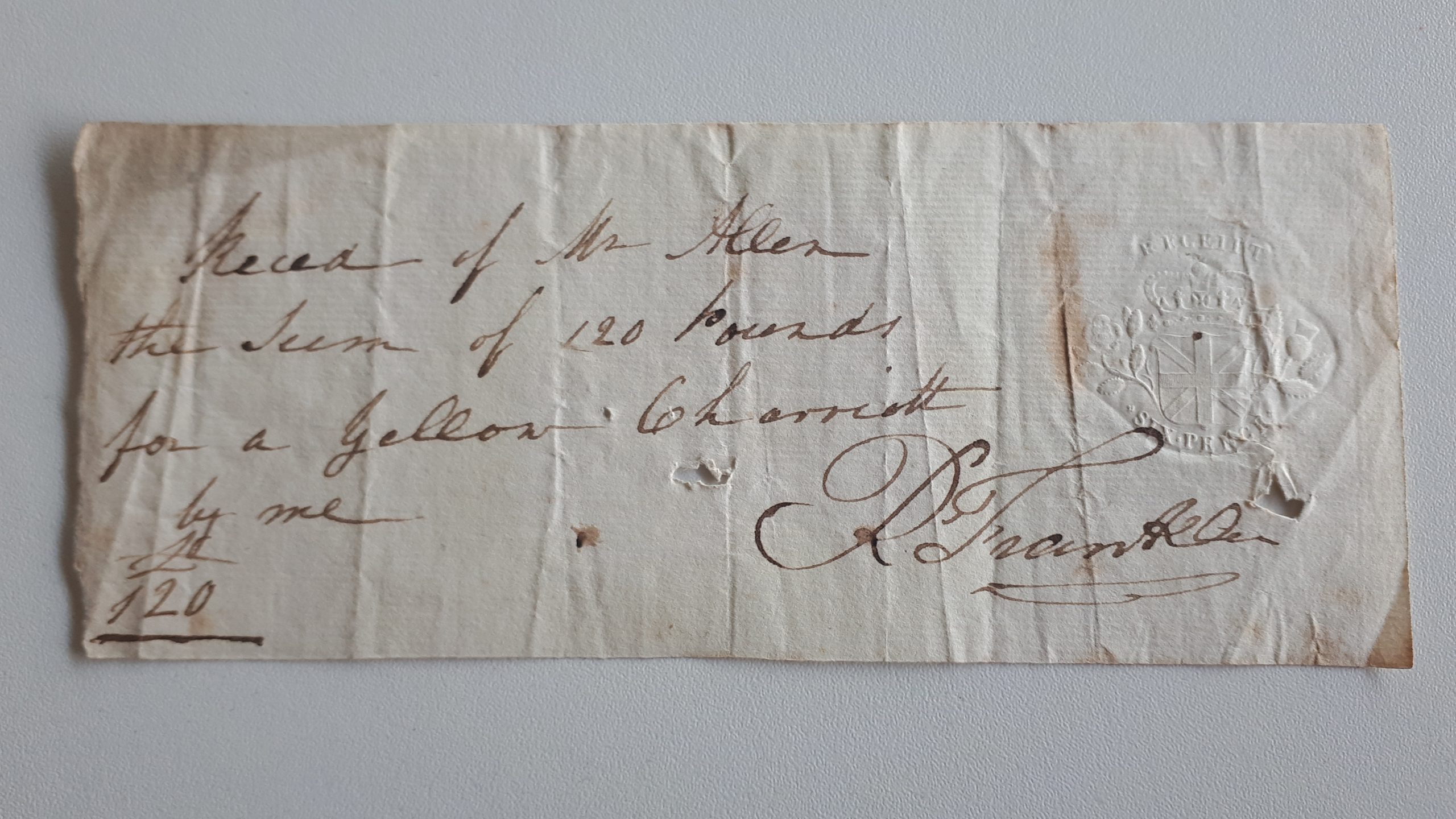
Receipt of Mr. Allen the sum of 120 pounds for a yellow Chariott by R. Franklin Ref 899.795 BA9276.6.1 © WAAS
Plot 195 of the Tithe map is described as Cottage and Wharf and the tenant is shown as William Hall. Due to the contemporary nature of the 1841 Census and Tithe Map, remarkably we also find the family on the Census operating the Rhydd Ferry with William listed as ‘Boat owner’. Being so close to the Quay or Wharf meant that at this time river transport was vital and no doubt used to ferry people and goods to and from the estate along the River Severn. Confirmation of the family’s use of and support of the Ferry and Rhydd Quay is demonstrated from several documents found in the Allen archive.

1841 Census showing members of the Hall family at the Rhydd Ferry (c) Crown Copyright
![Ferryman's Account [early 19th century] Ref 899.975 9276.6 (iii)© WAAS](https://www.explorethepast.co.uk/wp-content/uploads/2021/10/Ferrymans-Account-early-19th-century-Ref-899.975-9276.6-iii©-WAAS-scaled.jpg)
Ferryman’s Account [early 19th century] Ref 899.975 9276.6 (iii) © WAAS
![Receipt entitled ‘The Voluntiers ‘32’ [Hanly Quay] ale, bread, and chees[e] – 1.4.0’ [Hanley Castle] Ref 899.975 9276.6(ii) © WAAS](https://www.explorethepast.co.uk/wp-content/uploads/2021/10/receipt-entitled-‘The-Voluntiers-‘32’-Hanly-Quay-ale-bread-and-cheese-–-1.4.0’-Ref-899.975-9276.6ii-©-WAAS-scaled.jpg)
Receipt entitled ‘The Voluntiers ‘32’ [Hanly Quay] ale, bread, and chees[e] – 1.4.0’ [Hanley Castle] Ref 899.975 9276.6(ii) © WAAS
A receipt entitled ‘The Voluntiers ‘32’ [Hanly Quay] ale, bread, and chees[e] – 1.4.0’ [Hanley Castle] dated June 4th 1806 in John Henry Allen’s expenses and secondly a letter of much later date addressed to Isabella on behalf of Sir Edmund Lechmere (one of the few original documents held by WAAS that illustrate her later life in Madresfield) concerning a boundary dispute at The Rhydd Quay provide important evidence of the relationship between the Allen family and the importance of the Rhydd Quay or Wharf to the community of those living there. Who were the Voluntiers of Hanly Quay? Were they Militia or local families who helped with maintenance of the Quay? We will probably never know. However, these two documents illustrate to some extent the relationship that the Allen family had with the Quay and its inhabitants and the responsibilities that The Allen family had in terms of its operation and maintenance.

1851 Census showing the Allen family at Rhydd House
We can further illustrate that Isabella Ann Allen (alongside her passion for botany, as shown in her copy of The English Flora and explained in by the RHS in La Botaniste) following her father’s death in 1848 she becomes head of the family at Rhydd House part of a community whose affairs, like her father, took an active role in. By the 1851 Census she is listed as ‘Landed Proprieter’ and as Fiona Davison, Head of Libraries and Exhibition at the RHS comments in the initial report that there were clues “its original owner would have been a figure in the local society and in public”.
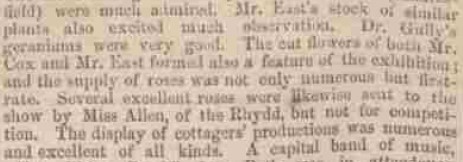
Newspaper report referring to ‘Roses sent to Malvern show by Miss Allen’ Worcestershire Chronicle, 4th July 1860
Thanks to newspaper reports of the time we can see Isabella’s enthusiasm for botany and growing having attended the Malvern Flower and Horticultural Show regularly between 1853-61 included other shows such as Hanley Castle, Upton and Ripple. On 4th July 1860 Isabella sent her own roses for display at Malvern as reported by the Worcestershire Chronicle which wrote ‘Several excellent roses were likewise sent to the show by Miss Allen, of the Rhydd, but not for competition’. The Malvern show appears to be an important event in the social calendar and fabric of life in Malvern with the likes of Dr James Gully, the man who helped to pioneer the Malvern Water Cure winning first prize for his Fuschias whilst his Geraniums were also described as ‘very good’.
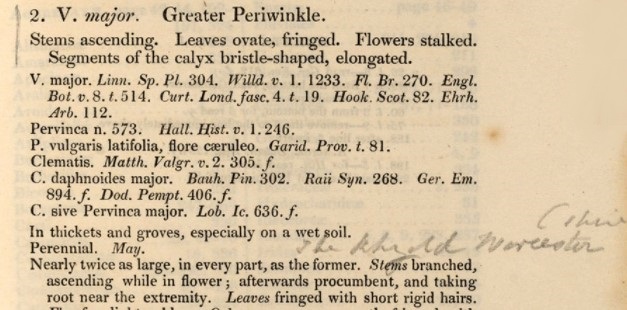
The Rhydd, Worcestershire, p339 The English flora, Sir James Edward Smith. 1824-1833. © RHS Lindley Collections
The RHS team at Lindley Library archives have kindly shared some pages from Miss Allen’s The English Flora and from the inscriptions on the pages, Isabella’s plant collecting was largely at a local level ‘with references to Worcestershire, the River Severn, Great Malvern, and critically Madresfield and the Rhydd as evidenced by the inscription which reads ‘The Rhydd Worcestershire’. Some of her other annotations demonstrate plant hunting trips further afield in Hertfordshire and Tewksbury. Isabella appears to have been an accomplished illustrator as evidenced by the drawing of herself above the inscription ‘La Botaniste’ and others. An entry uncovered by the RHS team in the Dictionary of English and Irish Botanists, 1994 records one Isabella Anne Allen (active 1820s), whose ‘flower paintings’ sold at auction in 1973. Some pencil verse on the title page from a poem by Thomas Moore written For Lady Dacre’s Tragedy Of Ina. which reads
“Simple as flowers, while yet unclassed they shone, Ere Science called their brilliant world her own, Ranged the wild, rosy things in learned orders, And filled with Greek the garden’s blushing borders!
and demonstrates a love of verse and of botany. Alongside her passion for botany and horticulture, Miss Allen hosted events such as a Picnic at The Rhydd in 1860 and supported good causes such as paying for the restoration of Malvern Priory.
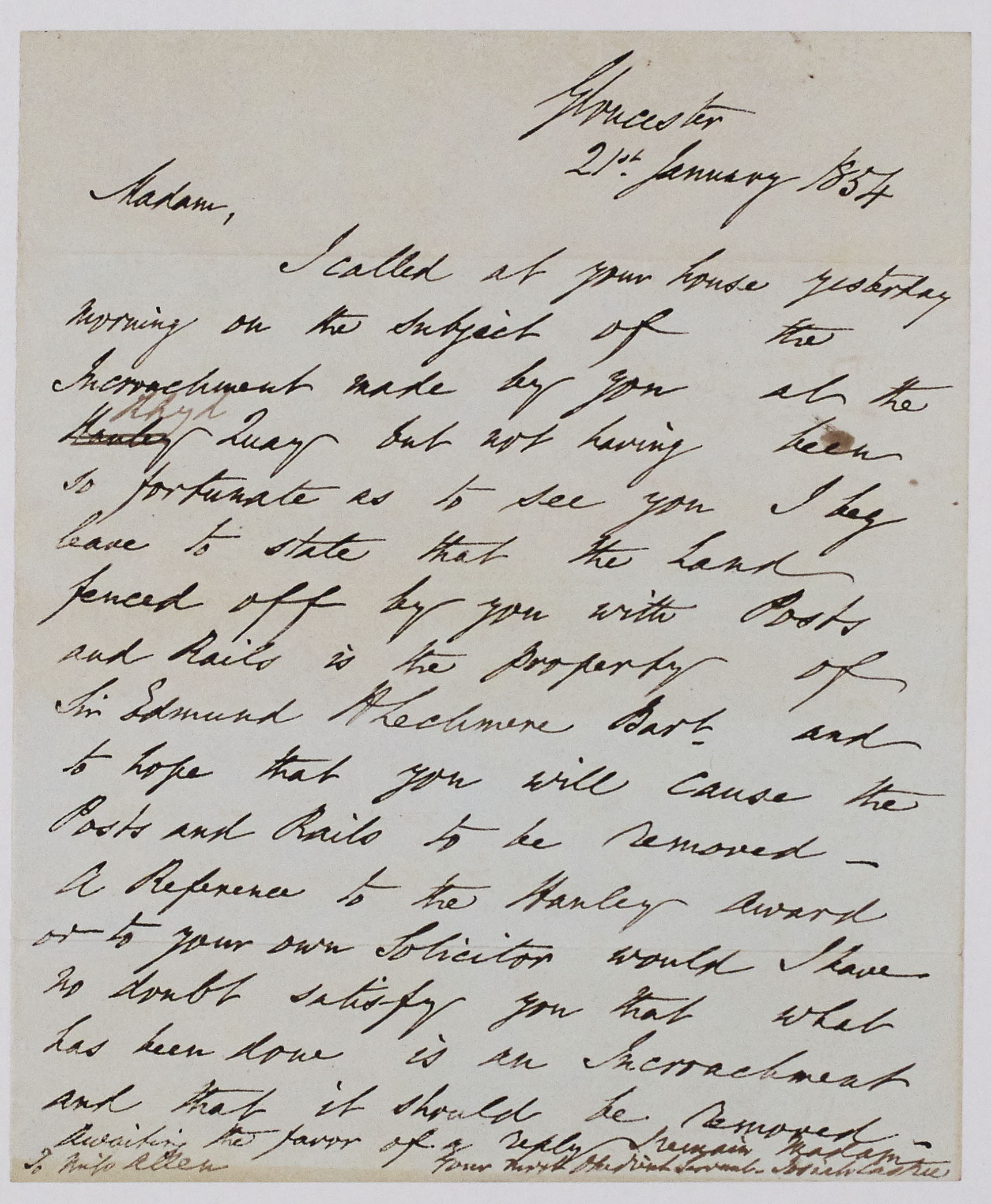
Letter to Miss Allen re Encroachments at the Rhyd Quay Ref 705.134 BA15311.18.3.10. ii © WAAS
Our earlier letter sent on behalf of Sir. Edmund Lechmere to Miss Allen entitled ‘Encroachment at the Rhyd Quay’ at Ref: 705.134 BA15311/18/3/10/I and some newspaper reports of 5th February 1859 and 9th July 1859 in the Berrow’s Worcester Journal regarding Rhydd Ferry improvements demonstrates Isabella was strong minded and a force to be reckoned with. She after all, according to her will, owned the Quay [Wharf]. The letter from a Josiah Castle? regards a boundary dispute and writes ‘I beg leave to state that the land fenced off by you with Posts and Rails is the Property of Sir. Edmund Lechmere Bart. And I hope that you will cause the Posts and Rails to be removed –‘ and refers her to the Hanley award. Separately, a claim for damages was made by ‘the Misses’ Allen following apparent damage sustained to Miss Ann Allen’s property which by the 1861 Census appears to have been a smaller residence on the Rhydd Quay next to the Rhydd toll house with her sister Ann – though they appear to have been absent. The second article references ‘Injuries’ that Miss Allen may have sustained because of a wall being built near her property but that neither her surveyor nor the trustees were at fault on this occasion.

1861 Census showing Isabella Ann Allen © Crown Copyright
Isabella no doubt understood that she was one of the lucky few women of her day who had financial independence thanks to her father. This can be inferred to some extent from her Will, but it is also worth noting that Isabella was living prior to the 1870 Married Women’s Property Act which created major change in nineteenth-century British property law. Until the passage of the Act, a husband had legal ownership over his wife’s personal property and managerial rights over her real property. This financial independence that she held may well have outweighed any decision to marry knowing the managerial rights and property rights that she would lose to any husband.
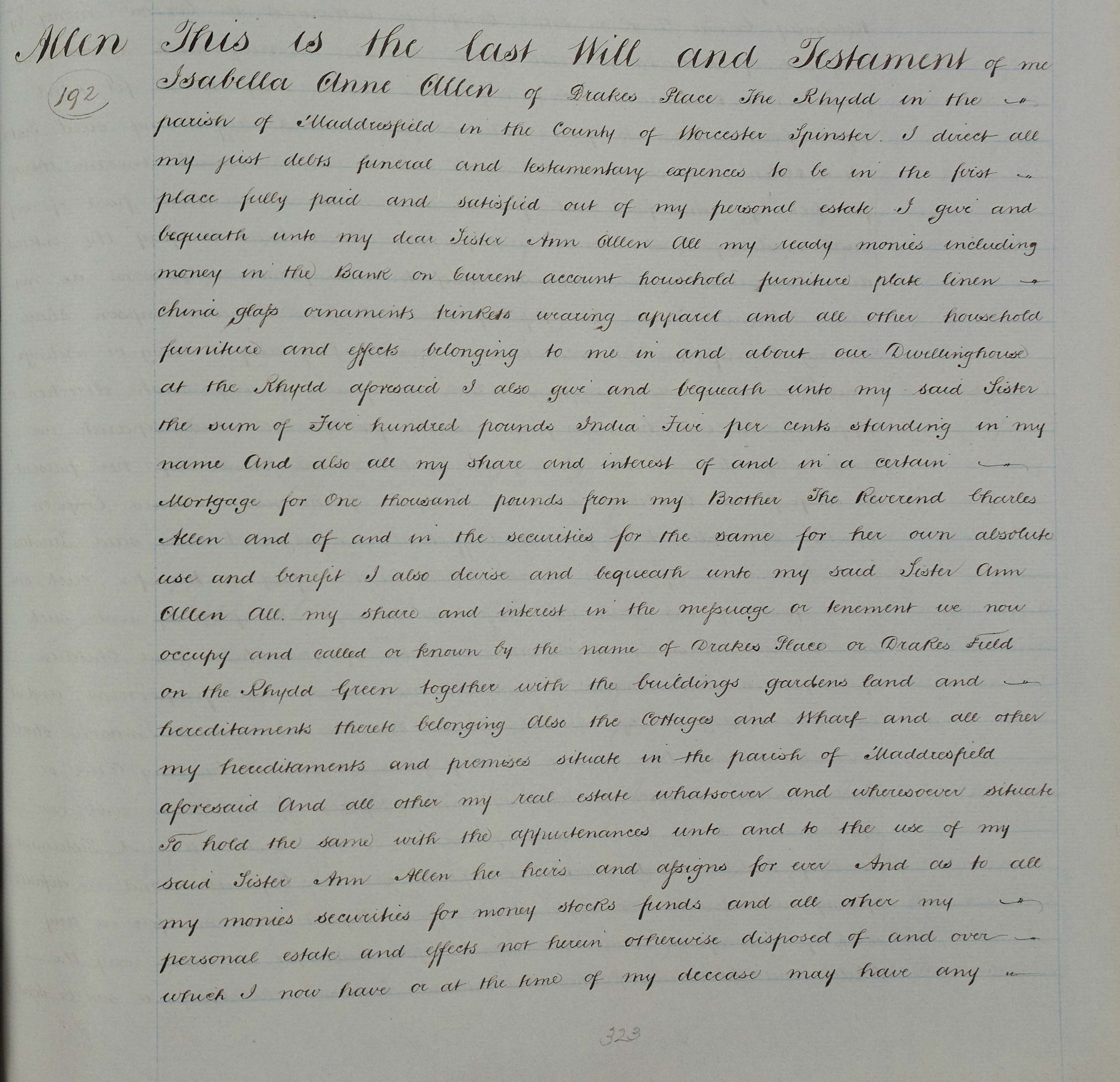
Will of Isabella Anne Allen, 1865, Ref: 008.7 BA3689 VOL 4 pp323 © WAAS
In her Will, Isabella left most of her fortune to her ‘dear sister Ann Allen’ who was sole executor of her will. She writes ‘I give and bequeath unto my dear Sister Ann Allen All my ready monies including money in the Bank on current account household furniture plate linen china glass ornaments trinkets wearing apparel and all other household furniture and effects belonging to me in and about our Dwellinghouse at the Rhydd aforesaid.’ She goes on to mention her mortgage share by saying ‘and of and in the securities for the same for her own absolute use and benefit I also devise and bequeath unto my said Sister Ann Allen All my share and interest in the messuage or tenement we now occupy and called or known by the name of Drakes Place or Drakes Field on the Rhydd Green together with the buildings gardens land and hereditaments thereto belonging Also the Cottages and Wharf and all other my hereditaments and premises situate in the Parish of Maddresfield aforesaid’.
Clearly her relationship with her sister Ann was treasured by Isabella during her lifetime and wanted to ensure she was well taken care of. However, and demonstrating Miss Allen’s desire that the fellow women in her family would have some financial freedom, in her will on behalf of her sister Maria Empson (nee Allen) she says the following…
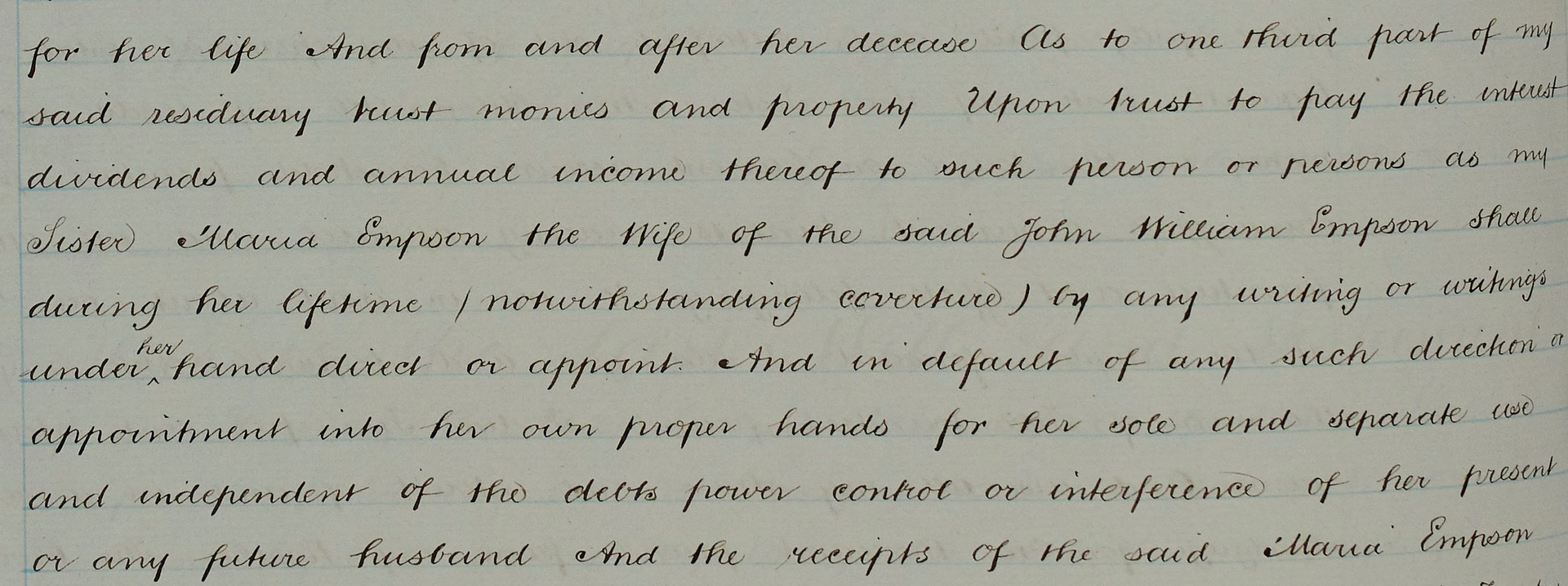
Will of Isabella Anne Allen, 1865 – Reference to sister Maria Empson (nee Allen) Ref: 008.7 BA3689 VOL 4.1 pp324 © WAAS
Therefore, Isabella wanted Maria to have some financial independence from her husband, John William Empson, given laws which did not work in favour of married women at this time.
![1871 Census showing Annie [Ann] Allen, sister of Isabella Ann Allen © Ancestry](https://www.explorethepast.co.uk/wp-content/uploads/2021/10/1871-Census-showing-Annie-Ann-Allen-sister-of-Isabella-Ann-Allen-©-Ancestry.jpg)
1871 Census showing Annie [Ann] Allen, sister of Isabella Ann Allen © Crown Copyright
Her remaining estate she divided between ‘Maria Empson’ second and ‘Reverend Henry Charles Allen’ and ‘Reverend John Henry Thomas Allen’ lastly and their descendants. Rather aptly, on the 1871 Census her sister Ann who is listed as Annie Allen is shown living at Rhydd House with her niece Margaret P. Empson. Whilst the life of Isabella Ann Allen has been partially revealed thanks to the RHS’ work and also documents held at WAAS, our digging through the archives revealed other interesting stories about the Allen family thanks to the Rev. Charles Allen whose personal notebooks and expenses are held as part of the Allen family archive. Alongside this, a single document about a ship called ‘Brunswick’ reveals a much bigger story which we hope to explore in the near future…

‘Brunswick’ Ref 899.975 9276.(i) i c.1790-1880 cropped © WAAS
Thanks to Teresa Jones and Julia Pincott for their advice and assistance with research and RHS Lindley for kindly allowing us to reproduce images from Isabella Ann Allen’s copy of The English Flora as shown in La Botaniste – a lady in the margins
Post a Comment